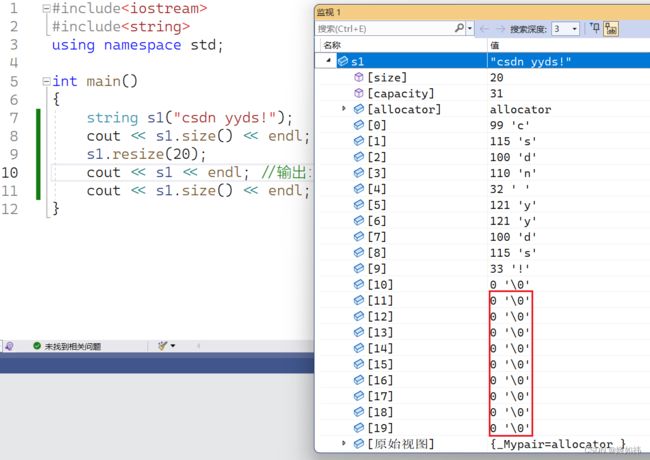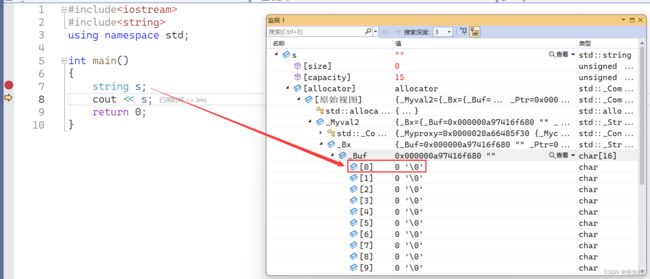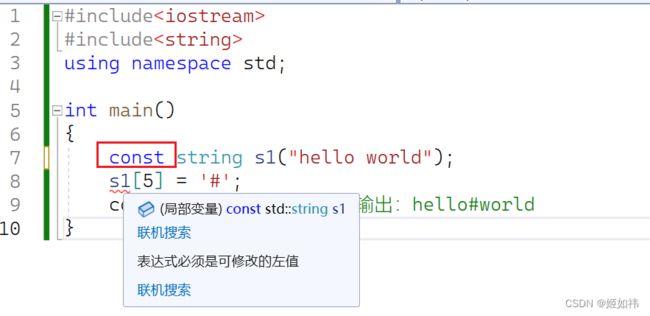C++string的使用
· CSDN的uu们,大家好。这里是C++入门的第十六讲。
· 座右铭:前路坎坷,披荆斩棘,扶摇直上。
· 博客主页: @姬如祎
· 收录专栏:C++专题
目录
1.构造函数
1.1 string()
1.2 string(const char* s)
1.3 string(const char* s, size_t n)
1.4 string(size_t n, char c)
1.5 string (const string& str)
1.6 string (const string& str, size_t pos, size_t len = npos)
2. size_t size() const
3. size_t length() const
4. size_t max_size() const
5. resize
5.1 void resize (size_t n)
编辑5.2 void resize (size_t n, char c)
6. size_t capacity() const
7: void reserve (size_t n = 0)
8. void clear()
9. bool empty() const
10. operator[]
11. char at(size_t pos)
12. char& back()
13. char& front()
14. operator+=
15. string& append (const char* s)
编辑
16. void push_back (char c)
17. insert()
17.1 string& insert (size_t pos, const char* s)
17.2 string& insert (size_t pos, size_t n, char c)
18. string& erase (size_t pos = 0, size_t len = npos)
19. void pop_back()
20. const char* c_str() const
21. find()
21.1 size_t find (const char* s, size_t pos = 0) const
21. 2 size_t find (char c, size_t pos = 0) const
22. rfind()
编辑
22.1 size_t rfind (const char* s, size_t pos = npos) const
22.2 size_t rfind (char c, size_t pos = npos) const
23. string substr (size_t pos = 0, size_t len = npos) const
1.构造函数
1.1 string()
这是 string 的无参构造,在 string 的底层就是构造了一个空字符串:“”,即在下标为 0 的位置存储了一个 '\0' 。
#include
#include
using namespace std;
int main()
{
string s;
cout << s;
return 0;
} 这是VS2022下看到的结果。VS对 string 的封装比较复杂,他一上来就开了很多空间,并且直接把开辟出来的空间全部初始化为了0。我们看到的现象会因编译器的不同有所差异。
1.2 string(const char* s)
这个构造函数表示可以使用常量字符串来初始化 string!或者使用字符数组来初始化,字符数组的数组名也是 char* 类型的嘛,char* 是可以用const char* 来接收的。
#include
#include
using namespace std;
int main()
{
string s("csdn yyds!");
cout << s << endl; //输出:csdn yyds!
char arr[12] = { 'c', 's', 'd', 'n', ' ','y' ,'y', 'd', 's', '!'};
string s1(arr);
cout << s1 << endl; //输出:csdn yyds!
} 1.3 string(const char* s, size_t n)
这个构造函数表示可以使用一个常量字符串 或者 字符数组的前 n 个字符来初始化 string。
#include
#include
using namespace std;
int main()
{
string s("csdn yyds!", 4);
cout << s << endl; //输出:csdn
char arr[10] = { 'c', 's', 'd', 'n', ' ','y' ,'y', 'd', 's' };
string s1(arr, 4);
cout << s1 << endl; //输出:csdn
} 1.4 string(size_t n, char c)
这个构造函数表示可以用 n 个 字符 来构造一个string对象。
#include
#include
using namespace std;
int main()
{
string s(8, '8');
cout << s << endl; //输出:88888888
} 1.5 string (const string& str)
这个构造函数表示可以使用另一个string对象来构造一个string对象(拷贝构造)。
#include
#include
using namespace std;
int main()
{
string s("csdn yyds!");
string s1(s);
cout << s1 << endl; //输出:csdn yyds!
} 1.6 string (const string& str, size_t pos, size_t len = npos)
这个构造函数表示可以用另一个 string 对象 从 pos 位置开始截取 n 个字符来构造一个 string 对象。
我们看到 len 参数有个缺省值:npos。这个 npos 是定义在 string 类中一个public属性的静态常量,其值为 -1。但是因为 len 的类型为无符号的整形,因此 len 的实际大小是无符号整形的最大值。我们可以直接打印 npos :
#include
#include
#include
using namespace std;
int main()
{
cout << (int)string::npos << endl; //int输出的npos
cout << string::npos << endl; //size_t输出的npos
cout << UINT32_MAX << endl; //32位机器下无符号整形的最大值
} 当我们的 pos + len 大于参数一字符串的长度时就是截取 pos 位置后的全部字符来构造string。不传 len ,len = npos 那可是相当大呢!所以不传 len 就是截取 pos 后面的全部字符来构造string。
#include
#include
using namespace std;
int main()
{
string s("csdn yyds!");
string s1(s, 5, 4); //从下标为 5 的位置(第一个y)向后截取 4 个字符来构造一个string
cout << s1 << endl; //输出 yyds
string s2(s, 5, 188); //len 传入很大
cout << s2 << endl; //输出 yyds!
string s3(s, 5); //不传len
cout << s3 << endl; //输出 yyds!
} 2. size_t size() const
这个函数用于返回一个 string 对象存储的有效字符的数量。为什么要有后面的那个const呢?我们知道这个const是修饰 *this 的,加上const 常对象与普通对象都可以调用啦!
#include
#include
using namespace std;
int main()
{
string s1("I love scdn!");
cout << s1.size() << endl; //输出:12
const string s2("csdn yyds!");
cout << s2.size() << endl; //输出:10
} 3. size_t length() const
这个接口跟 size_t size() const 实现的效果是一毛一样的!那你就可能会问了,为什么设计者要搞出来两个功能相同的接口呢?那是因为 string 类的出现早于 STL 库,string 在很久以前是没有 size() 这个接口的。但是呢 STL出现以后,求容器的大小都是实现的 size(), 于是 string 就也加上了一个 size() 接口!
4. size_t max_size() const
这个函数返回 一个string 对象多能存储的最多的字符数量,每个编译器的结果不尽相同!此函数用得也不多!
5. resize
5.1 void resize (size_t n)
在 string 的底层维护了一个字符数组,一个表示有效字符个数的size,和字符数组实际的容量capacity。而 resize 函数就是用来改变有效字符的个数的函数。
情况1:当 n 小于原字符串的大小,底层实现很简单,直接改变size,在添加一个 '\0' 表示字符的结束即可! 因此会保留原字符串的数据。
#include
#include
using namespace std;
int main()
{
string s1("csdn yyds");
s1.resize(4);
cout << s1 << endl; //输出:csdn
cout << s1.size() << endl; //输出:4
} 通过调试观察 string 的内存,也可以证明我的描述:
情况2: 当 n 大于原字符串的大小。会将原字符串的 size 扩展到相应的大小,但是在 VS2022 上,多余的空间他会全部初始化为 0 ,resize 之后的字符串的打印结果与原来并无不同。但是可以通过打印 size 来观察不同!
#include
#include
using namespace std;
int main()
{
string s1("csdn yyds!");
cout << s1.size() << endl; //resize之前输出:10
s1.resize(20);
cout << s1 << endl; //输出:csdn yyds!
cout << s1.size() << endl; //输出:20
} 通过观察 string 内存,能够证实我的讲解:
 5.2 void resize (size_t n, char c)
5.2 void resize (size_t n, char c)
这是一个重载的版本,在改变字符串大小的同时增加了初始化的功能!这个初始化的功能仅在 n 的大小大于原字符串的大小时生效(也就是 5.1 情况二的时候生效。)
#include
#include
using namespace std;
int main()
{
string s1("csdn yyds!");
s1.resize(20, 'a');
cout << s1 << endl; //输出: csdn yyds!aaaaaaaaaa
cout << s1.size() << endl;//输出:20
} 6. size_t capacity() const
我们刚才提到 string 的底层维护了一个 capacity 用来表示字符数组的实际大小,这个函数就是用来返回这个 capacity 的。此函数用得也不多!
不同编译器对于 string 维护的数组开空间的规则不同,因此返回相同字符串的capacity,不同编译器得到的值也不一定相同。下面是VS2022的结果:
#include
#include
using namespace std;
int main()
{
string s;
cout << s.capacity() << endl; //输出:15
} 7: void reserve (size_t n = 0)
这个函数是用来改变 string 维护的字符数组的实际容量的。
8. void clear()
清空一个字符串的内容,使之变为空串!
9. bool empty() const
判断一个字符串是不是空串!
10. operator[]
operator[] 能够使得字符串支持下标访问,这个是平时用得非常多的!他提供了两个版本,一个是非const版本,一个是const版本。const 修饰的string对象,通过下标访问得到的字符不允许修改。而非const的string对象通过下标访问得到的字符可以修改。
#include
#include
using namespace std;
int main()
{
string s1("hello world");
s1[5] = '#';
cout << s1 << endl; //输出:hello#world
} const修饰的string对象不可修改:
11. char at(size_t pos)
此函数完全可以被operator[]代替哈,at函数返回的是下标为 pos 的字符。 同样也有const版本和非const版本。
12. char& back()
该函数返回字符串的最后一个字符,同样也有 const 和非const 两个版本。
const版本:const char& back() const
非const版本:char& back()
#include
#include
using namespace std;
int main()
{
string s1("hello world");
char& tail = s1.back(); //非const支持修改
tail = 'C';
cout << s1 << endl;//输出:hello worlC
} 13. char& front()
该函数返回字符串的第一个字符,同样有 const 和非 const 两个版本。
const char& front() const
char& front()
14. operator+=
string 重载了 += 运算符,支持一个字符串加等一个字符,一个字符串常量,一个string 对象。
#include
#include
using namespace std;
int main()
{
string s("csdn yyds!");
s += 'a';
cout << s << endl; //输出:csdn yyds!a
s += "bbb";
cout << s << endl; //输出:csdn yyds!abbb
string tmp("ccc");
s += tmp;
cout << s << endl; //输出:csdn yyds!abbbccc
} 15. string& append (const char* s)
往一个string对象的末尾追加一个 常量字符串 或者 数组。
#include
#include
using namespace std;
int main()
{
string s1("hello ");
s1.append("world");
cout << s1 << endl; //输出:hello world
} 我们查阅 资料 发现 append 重载了很多版,是不是觉得string的设计有点冗余。个人感觉最好用的还是operator+=。
16. void push_back (char c)
往string后面追加一个字符,只能说非常鸡肋。不如operator+=。
17. insert()
我们可以看到 insert 重载了巨多版本,真令人头大呢!我们就讲讲两个具有代表性的。其他的都大同小异。
17.1 string& insert (size_t pos, const char* s)
该函数用于在pos位置插入一个 常量字符串 或者 字符数组(字符数组一定要有 '\0' 哦)。
#include
#include
using namespace std;
int main()
{
string s1("hello csdn");
s1.insert(5, " hi"); //在下标为5的位置插入 hi
cout << s1 << endl; //输出:hello hi csdn
} 17.2 string& insert (size_t pos, size_t n, char c)
该函数用于在pos位置插入n个相同的字符。
#include
#include
using namespace std;
int main()
{
string s1("hello csdn");
s1.insert(5, 5, '1'); //在下标为5的位置插入5个'1'
cout << s1 << endl; //输出:hello11111 csdn
} 18. string& erase (size_t pos = 0, size_t len = npos)
这个函数可以将从pos位置开始,后面的len个字符全部删除,不传len,表示len很大,也就是移除pos后面的所有字符啦!
#include
#include
using namespace std;
int main()
{
string s1("hello csdn");
s1.erase(0, 6); //移除下标 0 后面的6个字符
cout << s1 << endl; //输出:csdn
string s2("hello csdn");
s2.erase(1); //移除下标1后的所有字符
cout << s2 << endl; //输出:h
} 19. void pop_back()
这个函数简单,删除string的最后那个字符。
20. const char* c_str() const
这个函数可以返回 C风格的字符串。
#include
#include
using namespace std;
int main()
{
string s1("hello csdn");
const char* s = s1.c_str();
cout << s << endl; //输出:hello csdn
return 0;
} C风格的字符串:char类型的数组,每个下标对应一个字符,末尾有一个 '\0'。
21. find()
find 重载的版本也是比较多的呢!老规矩讲常用的!
21.1 size_t find (const char* s, size_t pos = 0) const
这个函数用来在一个string中,从pos位置开始查找一个常量字符串。pos不传的话就是从头查找。如果查找到了,返回起始下标,如果没有查找到返回 npos 。
#include
#include
using namespace std;
int main()
{
string s1("hello csdn");
//从下标为1的位置开始查找 csdn 这个常量字符串
cout << s1.find("csdn", 1) << endl; //输出:6
//从下标为7的位置开始查找 csdn 这个常量字符串
cout << s1.find("csdn", 7) << endl; //输出:4294967295(这是无符号整形的最大值)
cout << (int)s1.find("csdn", 7) << endl; //输出:-1
} 21. 2 size_t find (char c, size_t pos = 0) const
这个函数用来在一个string中,从pos位置开始查找字符 c。pos不传就是从头开始查找。一旦查找成功 (即从pos位置开始第一个字符 c ),返回查找成功的下标,否则返回 npos。
#include
#include
using namespace std;
int main()
{
string s1("hello csdn");
//从下标为 1 的位置开始查找字符'l'
cout << s1.find('l', 1) << endl; //输出:2
//从下标为 4 的位置开始查找字符'l'
cout << s1.find('l', 4) << endl; //输出:4294967295(这是无符号整形的最大值)
cout << (int)s1.find('l', 4) << endl; //输出:-1
} 22. rfind()
我们可以看到参数的形式跟find完全一样!rfind只是从后往前找罢了!
22.1 size_t rfind (const char* s, size_t pos = npos) const
表示:在 string 对象中从pos位置往前,查找常量字符串 s 。pos不传就是从末尾向前查找。查找成功,返回起始位置的下标,查找失败,返回 npos。
#include
#include
using namespace std;
int main()
{
string s1("hello csdn");
//从下标为 8 的位置往前,查找常量字符串 csdn
cout << s1.rfind("csdn", 8) << endl; //输出:6
//从下标为 5 的位置往前,查找常量字符串 csdn
cout << s1.rfind("csdn", 5) << endl; //输出:4294967295(这是无符号整形的最大值)
cout << (int)s1.rfind("csdn", 5); //输出:-1
} 22.2 size_t rfind (char c, size_t pos = npos) const
表示:从pos位置开始向前查找字符 c 。pos不传就是从末尾向前查找。一旦查找成功 (pos位置往前,第一个字符c的下标) 返回该下标,否则返回 npos。
#include
#include
using namespace std;
int main()
{
string s1("hello csdn");
//从下标为 8 的位置开始向前查找字符'c'
cout << s1.rfind('c', 8) << endl; //输出:6
//从下标为 5 的位置开始向前查找字符'c'
cout << s1.rfind('c', 5) << endl; //输出:4294967295(这是无符号整形的最大值)
cout << (int)s1.rfind('c', 5) << endl; //输出:-1
} 23. string substr (size_t pos = 0, size_t len = npos) const
这是用截取原string对象中的一部分连续字符,返回一个新的string对象。简言之:获取子串。
表示:从 pos 位置开始截取 len 个长度的字符来构造新的string。pos不传默认从头开始截取。len不传默认截取到末尾。
#include
#include
using namespace std;
int main()
{
string s1("hello csdn");
//不传len,默认截取到末尾,从 6 截取到末尾
cout << s1.substr(6) << endl; //输出:csdn
//从 0 开始截取 5 个字符
cout << s1.substr(0, 5) << endl; //输出 hello
} 总结:不需要死记硬背,用得多了自然就记得了!string的接口真的很多,记不起来查查文档就知道了!
string - C++ Reference (cplusplus.com)












